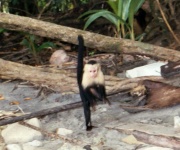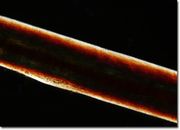Difference between revisions of "Monkey fur"
Jump to navigation
Jump to search
m (Text replace - "== Authority ==" to "== Sources Checked for Data in Record ==") |
|||
| Line 1: | Line 1: | ||
[[File:kmonkey.jpg|thumb|White-faced monkey]] | [[File:kmonkey.jpg|thumb|White-faced monkey]] | ||
== Description == | == Description == | ||
| − | + | [[File:monkeylarge.jpg|thumb|Monkey fur]] | |
Most natural monkey fur comes from the colobus, a small thumbless monkey of the family Colobinae native to the coasts of Africa. The black and white colobus, or guereza, has long, silky, black fur. Their pelts have long been used by native populations for decoration. In the early 19th century, monkey fur became popular in Europe and the animals were slaughtered to the point that the species is now endangered. Much of the monkey fur in the 20th century market was artificially made from Chinese human hair. | Most natural monkey fur comes from the colobus, a small thumbless monkey of the family Colobinae native to the coasts of Africa. The black and white colobus, or guereza, has long, silky, black fur. Their pelts have long been used by native populations for decoration. In the early 19th century, monkey fur became popular in Europe and the animals were slaughtered to the point that the species is now endangered. Much of the monkey fur in the 20th century market was artificially made from Chinese human hair. | ||
| Line 8: | Line 8: | ||
colobus; guerezas; monkey hair | colobus; guerezas; monkey hair | ||
| − | == | + | ==Resources and Citations== |
| − | |||
| − | |||
| − | |||
| − | |||
| − | |||
| − | |||
| − | |||
| − | * ''Encyclopedia Britannica'', http://www.britannica.com Comment: "colobus" | + | * ''Encyclopedia Britannica'', http://www.britannica.com Comment: "colobus" [Accessed November 15, 2001]. |
* Edward Reich, Carlton J. Siegler, ''Consumer Goods: How to Know and Use Them'', American Book Company, New York City, 1937 | * Edward Reich, Carlton J. Siegler, ''Consumer Goods: How to Know and Use Them'', American Book Company, New York City, 1937 | ||
| − | * | + | * Olympus Microscopy Resource Center at http://www.olympusmicro.com/galleries/polarizedlight/pages/monkeyhairsmall.html |
| − | * Wikipedia | + | * Wikipedia: http://en.wikipedia.org/wiki/Monkey (Accessed Nov. 9, 2005) |
[[Category:Materials database]] | [[Category:Materials database]] | ||
Latest revision as of 12:12, 23 August 2022
Description
Most natural monkey fur comes from the colobus, a small thumbless monkey of the family Colobinae native to the coasts of Africa. The black and white colobus, or guereza, has long, silky, black fur. Their pelts have long been used by native populations for decoration. In the early 19th century, monkey fur became popular in Europe and the animals were slaughtered to the point that the species is now endangered. Much of the monkey fur in the 20th century market was artificially made from Chinese human hair.
Synonyms and Related Terms
colobus; guerezas; monkey hair
Resources and Citations
- Encyclopedia Britannica, http://www.britannica.com Comment: "colobus" [Accessed November 15, 2001].
- Edward Reich, Carlton J. Siegler, Consumer Goods: How to Know and Use Them, American Book Company, New York City, 1937
- Olympus Microscopy Resource Center at http://www.olympusmicro.com/galleries/polarizedlight/pages/monkeyhairsmall.html
- Wikipedia: http://en.wikipedia.org/wiki/Monkey (Accessed Nov. 9, 2005)

